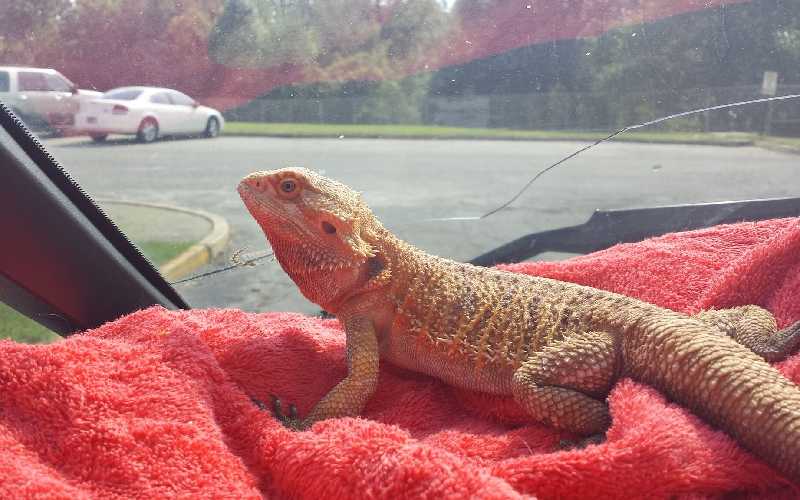A very popular question that I often get asked by Bearded dragon owners is ‘why is my bearded dragon basking?’ Today we will answer that question on our blog. But first, lets take a look at the basics on beardies…
The Basics on ‘Beardies’
At 16 to 24 inches long, weighing between 10 and 18 ounces, Bearded Dragons (Pogona), or ‘Beardies’, as they are fondly abbreviated to, are a genus of reptile. The genus contains 8 species of lizard, each species exhibiting the same ‘beard’ of spiked scales on the underside of their chin, which gives the creature its name. These trademark spikes can expand and ‘puff out’ as a defence mechanism to create a more impressive stature when under threat.
As prey, this threat can come to the ‘Beardies’ in several forms, such as black-headed pythons and birds of prey, but there is no significant threat from one specific predator.
However, they do not just act like prey, as their omnivorous diet consists of a mixture of insects and vegetation. In their lifetime, Bearded Dragons have been known to live up to 18 years in captivity, however, in the wild, this tends to be far shorter, closer to the realms of 4 to 10 years.
Bearded Dragons only exist in the wild in the warm, arid climates of Australia. Despite the Australian government banning the exportation of ‘Beardies’ in the 1960s, as one of the most common pet reptiles they are so commonly bred to be sold as pets that, in captivity, they are common outside of Australia too, particularly the Central Bearded Dragon.
What is Basking?
Basking is a behaviour exhibited by animals from almost every class. Mammals, invertebrates, birds, amphibians and reptiles all contain species that rely on the behaviour.
Basking is a thermoregulatory process, which means that reptiles will bathe in the heat of the sun to increase the temperature of their own bodies. This is because reptiles are ectothermic animals, meaning their metabolic systems do not produce enough heating by-products to maintain their core temperatures at a level above that of air or surface temperatures.
To bask, the reptile will find an elevated position at which they will lie perpendicular to the Sun’s rays, expand their rib cages, maximising surface area, and will darken their skin pigmentation to absorb more heat energy.
These mannerisms give the reptile the most effective and efficient absorption of the sun’s energy. If no sunlight is readily available, they will look to bury themselves in warm soil or place themselves beneath a large object which helps to maintain a warmer temperature.
Why is my Bearded Dragon Basking?
Animals bask for several reasons: to maintain thermoregulation by increasing body temperature; to reduce the energy needed for thermoregulation and/or to provide comfort. More recently, studies have found that basking also allows reptiles to regulate Vitamin D levels.
Bearded Dragons will often bask before periods of activity, to increase muscle and nerve function, assisting physiological performance when hunting or escaping predators.
Additionally, a warmer body temperature will generally increase the function of the immune and digestive systems, whilst Bearded Dragons have also been found to bask when pregnant. Without the ability to bask, lizards can lose function of the digestive system and other bodily processes, which can lead to serious health issues, such as impaction, a condition involving blockage of the intestine.
The reptiles are semi-arboreal, which means that they can inhabit trees or raised areas, and they will often climb to find these optimal basking areas. Competition for raised areas has been found and linked to dominant behaviour, so potentially, Bearded Dragons use basking and basking areas as a show of their superiority over rivals and territory.
What Can I Do to Help?
For owners of ‘Beardies’, when caring for your reptile, arguably the most difficult and important thing to achieve is temperature regulation within their enclosure.
The perfect range of temperatures to provide your pet is known as the preferred optimum temperature range (POTR), which allows them to experience all the thermoregulatory changes that they would in the wild.
For Bearded Dragons, a desert reptile, the basking spot should be kept at 31℃ to 38℃ during the day, and 21℃ to 24℃ at night, to best imitate the conditions of the Australian deserts. Basking is an essential part of a Bearded Dragons life, and providing your ‘Beardie’ with the ability to bask is one of the key challenges of being an owner!
If you enjoyed this article you might also like to read about Bearded Dragon Lay Box


1 thought on “Why is my Bearded Dragon Basking?”